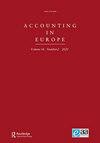Articulation, Profit or Loss and OCI in the IASB Conceptual Framework: Different Shades of Clean (or Dirty) Surplus
IF 4.3
Q1 BUSINESS, FINANCE
引用次数: 4
Abstract
Abstract The 2015 International Accounting Standards Board (IASB) Conceptual Framework Exposure Draft (2015 IASB CF ED) proposes a mixed valuation and transactions approach to income determination. Nevertheless, it does not clearly choose between single or dual concepts of profit, which renders the 2015 IASB CF ED’s financial accounting model somewhat incoherent. The 2015 IASB CF ED proposes a rebuttable presumption that profit or loss should be all-inclusive. Only the IASB can rebut this presumption, but the 2015 IASB CF ED provides no clear conceptual basis on which to rebut this presumption. In spite of considering dual measurement, the IASB believes that it is neither possible, nor necessary, to distinguish between profit or loss and other comprehensive income (OCI) on a conceptual basis. This paper suggests that the 2015 IASB CF ED’s approach to measurement can be improved by introducing a deprival value measurement rule in cases where fair value and historical cost are not appropriate. Furthermore, it argues that under dual measurement it is both necessary and possible to make a conceptual distinction between the realised items of income and expense in profit or loss and those recognised by accretion in OCI.国际会计准则理事会(IASB)概念框架中的表述、损益和OCI:不同程度的净(或脏)盈余
2015年国际会计准则理事会(IASB)概念框架征求意见稿(2015 IASB CF ED)提出了一种用于确定收益的混合估值和交易方法。然而,它并没有明确选择单一或双重的利润概念,这使得2015年IASB CF ED的财务会计模型有些不连贯。2015年IASB CF ED提出了一个可反驳的假设,即利润或亏损应包括一切。只有IASB可以反驳这一假设,但2015年IASB CF ED没有提供明确的概念基础来反驳这一假设。尽管考虑了双重计量,但IASB认为,在概念基础上区分利润或亏损与其他综合收益(OCI)既不可能也没有必要。本文建议,在公允价值和历史成本不合适的情况下,可以通过引入剥夺价值计量规则来改进2015年IASB CF ED的计量方法。此外,本文认为,在双重计量下,在损益中的已实现的收入和费用项目与在保本金中以增额确认的项目之间进行概念区分是必要的,也是可能的。
本文章由计算机程序翻译,如有差异,请以英文原文为准。
求助全文
约1分钟内获得全文
求助全文

 求助内容:
求助内容: 应助结果提醒方式:
应助结果提醒方式:


